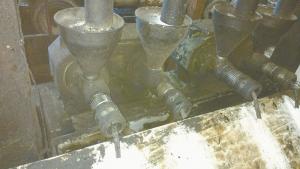2018 - Volume #42, Issue #3, Page #09
[ Sample Stories From This Issue | List of All Stories In This Issue | Print this story
| Read this issue]
He Makes His Own Fuel With On-Farm Biodiesel Plant
 |
 |
“It only takes a few minutes a day to make biodiesel at a cost of about $1.75 per gal.,” says Nickolay. “When we started in 2006, diesel fuel was pushing $4 per gal., and the equipment paid for itself quickly. Even today, it’s saving us money.”
Faced with high fuel prices, Nickolay read about a Wisconsin man who was making biodiesel. The man shared his experience with him and helped set him up with needed equipment, selling him a German-made Comet press. Nickolay had a local metal fabricator make a 400-gal. reactor with pumps and heater.
“The only problem with the press is getting parts from Germany when pieces wear out,” he says. “The guy I bought my press from is getting out of the business, so I have to find a new supplier.”
Nickolay keeps wear to a minimum by using “sacrificial” belts. Although the press gearbox has a double pulley drive, Nickolay uses only one belt and tightens it down.
“If a piece of bearing or something enters the press, the belt will burn out before the chrome-plated parts get scratched,” he explains. “Once the chrome is scratched, it wears much faster.”
Nickolay avoids using soybeans, in part because of their low oil content, but also to avoid rocks and dirt picked up by the combine. Instead, he plants about 100 acres of sunflowers and about 40 acres of canola each spring. Seed is pressed in 50-bushel batches, with sunflower seed producing about 50 to 60 gal. of oil per batch and canola seed producing 90 gal. of oil per batch.
While the meal is pushed off to the side for use in Nickolay’s cattle ration, the oil is collected in a large plastic tank. Most of the sediment in the oil drops out as the oil enters the tank. Once a day the oil is pumped to a second plastic tank where it settles over a 5-day period.
“The sediment from the first tank is fed to young stock by the bucket full,” says Nickolay. “They will follow me through the yard for it.”
Oil at the top of the second tank gets pumped into a 400-gal. stainless steel reactor tank. He heats the oil to 120 degrees. Nickolay adds about 15 1/2 lbs. of potassium hydroxide flakes to 30 to 35 gal. of methanol. Sunflower oil gets a little more potassium hydroxide, while canola gets a little less.
Once the flakes are dissolved, the methanol solution is pumped into the reactor tank. Pumps on the bottom of the tank recirculate the methanol-oil mix to the top of the tank for about a 3-hr. period. Nickolay leaves it in the reactor for a day or so. This allows glycerin (a byproduct) to settle out, with more settling out while the biodiesel is in storage.
Nickolay estimates getting about 35 gal. of glycerin per batch of fuel. When he has collected about 300 gal. or so from storage tanks, he heats it up and pushes air through it.
“I reclaim about 50 gal. of methanol per batch for reuse in the reactor,” says Nickolay.
The biodiesel is pumped into the farm’s 10,000-gal. fuel barrel or into smaller plastic totes. “We pump the biodiesel off the top of the tanks as we need it,” says Nickolay. “We burn the oil straight in older equipment, but mix it 50:50 with diesel fuel for use with engines 2005 and newer.”
He explains that fuel filters on the newer equipment are too tight to allow the biodiesel molecules through.
“The equipment does require an up-front investment, but if you have the land to produce your own seed and cattle to feed the meal to, the cost to produce biodiesel drops pretty fast,” says Nickolay.
Contact: FARM SHOW Followup, Shannon Nickolay, D2186 Cty. Rd. C, Stratford, Wis. 54484 (ph 715 305-4735; charity.nikolay@yahoo.com).

Click here to download page story appeared in.

Click here to read entire issue
To read the rest of this story, download this issue below or click here to register with your account number.




